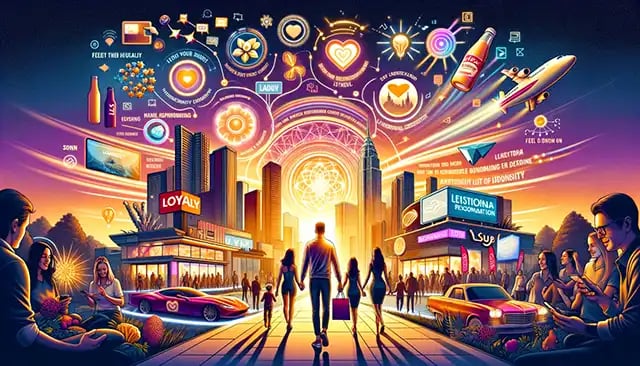Boost Your Business with Smart Brand Marketing Strategies
- Home
- Boost Your Business with Smart Brand Marketing Strategies
Imagine stepping into a world where your business not only survives but thrives, thanks to the power of brand marketing. Crafting a brand's identity goes far beyond merely plastering a logo on items or flooding social media platforms with promotional content. It's deeper; it's about forging an unbreakable bond between you and your audience.
In this journey, we'll dive into why brand marketing stands as the cornerstone for building memorable identities that resonate well beyond the checkout page. Embarking on this voyage, we're blending artistry with innovation to sculpt enduring tactics that not only distinguish you in saturated arenas but also prepare you for tomorrow's challenges, promising revelations that might just redefine your strategy and elevate your standing amidst the competition.
And if nurturing long-term customer relationships sounds like climbing Everest barefooted, worry not. We're peeling back layers on how emotional connections can turn first-time buyers into lifelong advocates without resorting to gimmicks or fleeting trends.
Alright, strap in; we're about to dive into this journey of transformation side by side.
Table Of Contents:
- Introduction to Brand Marketing
- Importance of Brand Marketing
- Crafting Your Brand Identity with HubSpot
- Target Audience Analysis for Effective B2B Marketing
- Strategic Brand Marketing Tactics
- Building Long-Term Customer Relationships through Brand Loyalty
- The Role of Technology in Future-Proofing Your Brand Marketing
- Navigating B2B Brand Marketing Challenges with HubSpot
- FAQs About Brand Marketing
- Conclusion

Introduction to Brand Marketing
Brand marketing delves into the essence of storytelling and value-sharing, transcending mere transactions to foster deep connections. Effective brand strategy is about crafting a narrative and ethos that resonate with your audience and forges a deep relationship that transcends mere purchases. Think Apple products - it’s not just about the tech; it’s how people feel using them.
This approach to brand positioning emphasizes the overall strong brand rather than focusing solely on specific products or services. Why? Successful brand marketing creates repeat buyers and fosters long-term relationships by tapping into customers' emotions, making them loyal advocates for years.
Importance of Brand Marketing
Navigating the bustling bazaars of today's commerce, differentiation becomes not just beneficial but essential. But what sets brand marketing apart from traditional product marketing? Simple: its ability to connect deeply with audiences through stories, experiences, and shared values.
Its significance is monumental, truly beyond measure. Brands that master this craft don’t just sell; they become part of their customers’ lives—think Nike or Coca-Cola—and in doing so, achieve memorable business identity status which boosts both recognition and loyalty significantly.
A strong example of brand purpose driving customer loyalty comes from Super Bowl ads where companies spend millions on a marketing plan not primarily to push product features but to create unforgettable moments tied closely to their core values and mission—aiming for an emotional impact to build brand image that lasts far longer than any single purchase cycle would suggest. According to statistics, effective branding strategies like these are key in turning casual shoppers into lifelong fans because they emphasize a company’s personality over its inventory list.
Crafting Your Brand Identity with HubSpot
Establishing Your Brand's Visual Identity
A solid brand identity is like your business's fingerprint—unique and distinguishable. Crafting this identity is not merely about selecting colours or creating logos; it's a comprehensive process that visually articulates the essence and principles of your brand. When you're using HubSpot for branding, you get to leverage tools that guide design consistency across all platforms, ensuring every piece of marketing material tells part of your brand's story.
Consider the building blocks of visual identity: logos, colours, typography, and imagery. The components of your visual identity should not only mirror the essence of your values but also resonate with those you aim to reach. It’s good practice to create brand guidelines that outline how these visuals should be used—including dos and don'ts—which can help maintain brand consistency whether you’re crafting social media ads or updating website content.
Leveraging HubSpot's Tools
Now let’s talk about cohesion because having a strong visual identity means nothing if it isn’t consistent across all channels. This is where HubSpot shines by supporting cohesive branding efforts. With its suite of tools, managing campaigns becomes easier as they allow for uniform messaging throughout email marketing, landing pages, social media posts—and beyond.
The platform offers analytics too so you can see which aspects of your branding resonate most with audiences helping inform future decisions on style tweaks or total overhauls when necessary. Keep in mind, that keeping your brand's identity consistent doesn't imply it should remain unchanged; as brands grow and change, their identities must adapt alongside them. By monitoring engagement levels closely through HubSpot's analytics features, businesses have the opportunity to not only keep up with trends but stay ahead of them.
Target Audience Analysis for Effective B2B Marketing
Tailoring your brand marketing strategies to fit the needs and interests of your B2B target audience is more than a good idea—it's essential. With tailored messaging shown to increase engagement by up to 50% in B2B markets, understanding who you're talking to isn't just part of the game; it's how you win it.
Identifying Your Ideal Customer
Finding ways to pinpoint exactly who benefits most from your services or products is step one. This means diving deep into demographics, job roles, industries, and even psychographics. Tools like HubSpot’s analytics can help paint a clearer picture by providing valuable insights into customer behaviours and preferences.
Beyond just knowing their age or job title, ask simple questions about what challenges they face daily. What are the answers they're fervently hunting, yearning to uncover? Gaining this understanding paves the way for interactions that not only engage but also profoundly connect, by tailoring messages to echo their innermost needs and challenges.
Leveraging Analytics for Insightful Engagement
Analyzing data gathered through platforms like HubSpot gives you an edge in creating marketing materials that speak directly to the heart of your audience's needs. It lets you segment audiences based on various factors including past interactions with your brand which can significantly boost brand awareness and foster authentic connections.
This strategic approach not only enhances current marketing efforts but also informs future campaigns ensuring they are aligned with evolving customer expectations and trends within specific industries.
The Power of Personalization in Communication
Achieving effective B2B branding is a long-term strategy that hinges on crafting messages that feel personal because let’s face it—we’re all social animals craving connection even in business contexts. When customers feel understood and valued at this individual level, loyalty grows paving the way for long-term relationships crucial for sustained growth as companies with strong loyalty programs grow revenues 2.5 times faster than their competitors shows us why investing time into knowing our customers pays off big time.
Master B2B marketing by tailoring strategies to your audience's needs, using tools like HubSpot for insights. Personalized messages boost engagement and loyalty, key to outpacing competitors.

Strategic Brand Marketing Tactics
Effective Branding Strategies
In the world of brand marketing, storytelling and creating emotional connections are not just fluff; they're essential tools. Research indicates that brands capable of establishing a deep emotional bond may witness their customer's lifetime value skyrocket upwards of 300%. Transforming your audience into devoted supporters, who resonate with your ethos, is the essence of brand loyalty.
So how do we achieve this? First off, understand that every piece of content or advertisement is a chance to tell your story. Apple products are often seen as much more than gadgets because their marketing tells a story of innovation and quality life improvement. That narrative resonates deeply with consumers, illustrating the power of effective storytelling in branding.
Creating Emotional Connections
Making customers feel something towards your brand goes beyond just showcasing product features. For instance, tapping into social media ads allows you to reach out directly and engage on a personal level. When people see real stories from others they can relate to—whether it’s overcoming challenges or achieving dreams—they’re more likely to form an authentic bond with your brand.
This approach isn’t just beneficial; it’s necessary for long-term success. Remember those stats about emotional connections boosting customer value? They highlight why focusing on heartstrings rather than purse strings makes for a solid brand marketing strategy.
Leveraging Social Media Ads
Social media ads offer an unparalleled opportunity to amplify these strategies further. By targeting specific demographics based on interests or behaviours, brands can craft personalized messages that resonate well with their target audience—a tactic known for increasing engagement significantly.
Beyond simply pushing sales pitches, these platforms enable brands like yours to share behind-the-scenes looks at company culture or how products are made which fosters transparency and trust—an essential building block in any successful relationship between businesses and consumers.
Storytelling and emotional connections aren't just nice-to-haves in brand marketing; they're must-dos that can boost customer value by 300%. Use every ad and content piece to tell your story, like how Apple showcases innovation. Also, leverage social media ads for direct engagement and authentic bonds with your audience.

Building Long-Term Customer Relationships through Brand Loyalty
The Essence of Brand Marketing for Loyalty
Brand loyalty isn't just about customers choosing you over competitors. Crafting a world where your brand is the only option in their minds sets the stage for unwavering devotion. This magic happens when your brand becomes a part of their identity, something companies with strong loyalty programs know all too well as they grow revenues 2.5 times faster than those without.
To foster this level of commitment, it’s crucial to focus on more than just transactions. Rather, forge bonds through continuous delivery of worth and engaging profoundly. Keep in mind, that the foundation of continuous business expansion lies in nurturing enduring connections with customers.
Leveraging Emotional Connections
An emotional connection is often the difference between a one-time buyer and a lifelong advocate. Studies show that such connections can increase customer lifetime value by more than 300%. But how do you create these bonds? By understanding what drives your customers beyond their immediate needs and speaking directly to these motivations in every interaction.
Your marketing efforts should aim not only to meet expectations but exceed them at every turn—whether through personalized experiences or community-building initiatives that make customers feel seen and valued.
Crafting Engaging Experiences Through Technology
In today’s digital age, technology plays a pivotal role in crafting experiences that keep customers coming back for more. In an era where AI-powered customization spearheads the evolution of brand trends, companies now have unparalleled chances to forge profound connections with their audience.
Adopting tools like HubSpot enables brands to analyze data effectively ensuring messages resonate with target demographics while maintaining consistency across all channels—a key factor in building brand recognition and trust which are essential components of loyalty.
In essence, successful brand marketing strategies hinge on understanding human psychology: making people feel included creates powerful advocates out of ordinary consumers because we're inherently social animals seeking connections wherever we go—your brand could be the next stop if played right.
Boost loyalty by making your brand part of customers' identities, going beyond transactions to build relationships, and leveraging tech for personalized experiences. Remember, emotional connections turn buyers into lifelong fans.

The Role of Technology in Future-Proofing Your Brand Marketing
In the ever-evolving landscape of brand promotion, tech advancements are swiftly altering the playbook. As we dive deeper into the digital age, understanding and leveraging emerging technologies like AI is no longer optional; it's essential for staying ahead.
Trends indicate a significant shift towards personalized experiences driven by AI technology in the next decade. This isn't just speculation; adapting early can give brands a competitive edge that's hard to match. Here's why it's crucial to pay attention.
Futuristic Trends in Branding
Incorporating technology into your brand marketing strategy isn't about jumping on every new gadget or platform that comes out. It involves cleverly leveraging technology to serve both your brand's needs and those of your audience in a meaningful way.
Consider how personalized experiences have evolved thanks to tech advancements. We're not just talking about adding someone’s name at the top of an email anymore. Imagine providing product recommendations based on browsing habits or sending customized offers directly through social media ads—all possible with AI and machine learning.
Technology’s Role in Branding
Leveraging tech in a way that mirrors your brand's essence and principles is crucial for maintaining authenticity. For instance, if sustainability is a core part of your company’s personality, utilizing digital platforms to minimize paper use speaks volumes more than traditional mailers ever could.
Moreover, engaging with customers where they spend their time—on social media—is crucial but doing so authentically will set you apart from competitors who might seem disconnected despite their online presence. Emerging technologies are shaping future branding strategies, making now the perfect moment to rethink how we connect with our target audience using these innovative tools.
Navigating B2B Brand Marketing Challenges with HubSpot
B2B branding challenges are unique, often requiring a delicate balance between understanding the complex needs of business clients and crafting messages that resonate. Fortuitously, with HubSpot at your side, what once were hurdles can now be transformed into stepping stones for expansion.
Leveraging HubSpot
HubSpot is not just another tool in your arsenal; it's a powerhouse designed to address specific B2B branding challenges head-on. With its comprehensive CRM platform, businesses have seen an average increase in sales productivity by up to 34%. This enhancement transcends mere tidiness—it crafts deeper, more resonant engagements with potential clients at each twist and turn of their path.
The beauty of using HubSpot lies in its ability to integrate various aspects of brand marketing campaigns seamlessly. From social media management and email marketing to content creation and analytics, everything you need is housed under one roof. This integration ensures that all parts of your brand marketing strategy are aligned towards the same goals: building awareness and fostering authentic brand engagement.
Overcoming Common Hurdles
A major hurdle many B2B companies face is maintaining consistency across all channels while also personalizing experiences for different segments within their target audience. Here’s where HubSpot’s suite of tools shines brightly. It allows you to customize messaging without losing sight of your core brand identity—think consistent use of colour palettes, logos including logos on varying platforms yet tailoring the conversation based on customer data insights gathered within the CRM.
Navigating the maze of accurately gauging the impact of marketing initiatives extends beyond merely tallying clicks or views. HubSpot's platform, equipped with intricate analytics tools, unveils the mystery behind successful strategies through advanced reporting functions, offering teams a profound comprehension of their effectiveness and laying the groundwork for enhancing upcoming initiatives aimed at long-term objectives.
HubSpot turns B2B branding challenges into growth opportunities by streamlining campaign management and enhancing personal connections with prospects, proving that understanding complex needs and crafting resonant messages can coexist.
FAQs About Brand Marketing
What are the 4 P's of branding?
The 4 P's stand for Product, Price, Place, and Promotion. They guide how you position your brand in the market.
What is branding in marketing examples?
Nike’s swoosh and Apple’s bitten apple icon show how logos capture a brand's essence and values vividly.
What is good branding marketing?
Good branding resonates with people. It tells a story that connects on an emotional level, making the brand unforgettable.
Why is branding important in marketing?
A strong brand marketing strategy sets you apart from competitors. It's a long game that builds trust and loyalty by giving your business a memorable identity.
Conclusion
Brand marketing is the heart of connecting with your audience. Delving deeper than mere symbols or advertisements, it's fundamentally about forging meaningful connections.
Crafting a visual identity goes beyond mere creativity; it's an expression of your fundamental principles, striking a chord with the people you aim to serve.
Leverage technology, but don't lose sight of the human touch. Emotional connections make customers stick around for the long haul.
Ultimately, being flexible and tackling obstacles head-on primes you for triumph. Use tools like HubSpot wisely to stay ahead in the game.
In essence, keep it real, stay consistent, and always aim to foster deeper bonds. That’s brand marketing at its best.



